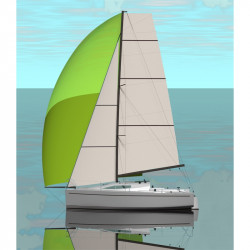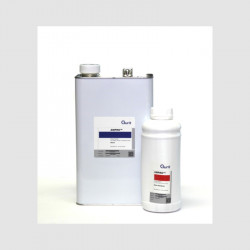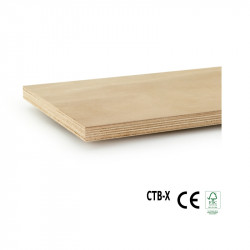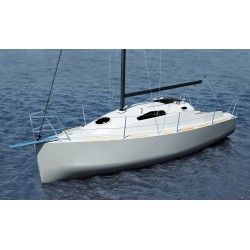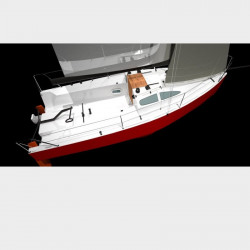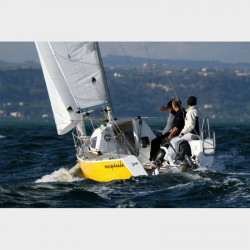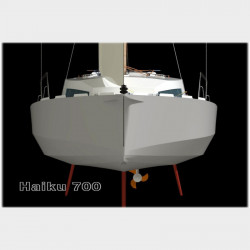Cristian Pilo Projet

Idea 850 is the development of the concept of Idea 19 and Idea 21 on a bigger scale, so she’s basically an offshore fast paced cruiser, that can be tuned as a racer with some attention to keep her light during the building process (weight savings modifications are described in plans**);
Hull: hull features a chine on two thirds of her length, to gain the maximum shape stability in the first 30 degrees of heeling, a wide but not humongous beam, flat transom sections to have a good planing attitude downwind and reaching, and very powerful U shaped section at the bow ; the stability curve points out a high righting moment to cope with the real generous sailplan , and a more than good 124° of AVS (angle of Vanishing Stability)

building process: Hull has to be build with strip planking system in wood and epoxy resin, on a scaffold made by cheap wood temporary frames, hull is internally and externally laminated with a layer of biaxial glass, then turned on her cradles, all the other wooden structures (stringers, stempost-backbone, bulkheads and floors) will be bonded and laminated internally; all the cabin, deck and cockpit surfaces are made in marine grade plywood built with "stitch & glue" system.
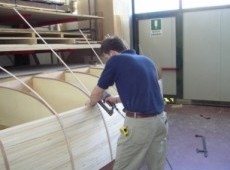
laying strips
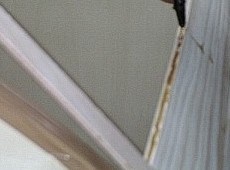
bonding stripes
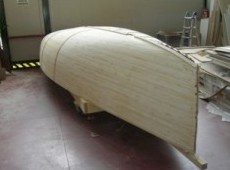
The finished hull
Deck, deckhouse and cockpit are designed to be built in 12 mm plywood panels, with the "stitch and glue" system; the spaces in the cockpit allow single or double cruising, but also offer generous space for 4-5 people on a cruise; as on the little idea 21 and on the Hirundo 750 there is a dedicated box at the stern for a 6-seater life raft; the interiors are not structural, so you can modify them according to your needs.

keel: fixed, with a 600 kg lead bulb bolted on a NACA profiled welded steel finkeel , bolted on solid wood floors with 20 high strength steel bolts ; if required a shallow draft keel solution will be included in plans, standard draft is 1,90 m at 2750 kg displacement
rudders and steering system: double NACA shaped rudders transom hung with a central tiller , drawings are highly detailed to built a reliable and strong steering system.
Sailplan: two swept spreaders mast stepped on deck, aluminum alloy or carbon , two versions of sailplan will be detailed on plans :
-Sport Cruising : moderate roach on mainsail, olympic jib, code zero on furler on fixed (optional) bowsprit), fractional gennaker , single backstay, babystay and not structural runners for heavy weather
-Regatta: square top full battened mainsail, retractable alloy or carbon bowsprit that can be pivoted, olympic jib with 3d system sheeting point , code zero
on bowsprit, masthead and fractional gennaker , double backstay and runners


engine : inboard diesel or electric engine, saildrive or shaft transmission, up to 20 HP for diesel engine ; drawings detail the engine fitting and related systems
on board living: boat is quite roomy both in the cockpit and in the cabin, interiors features a separate toilet room, 5 fixed berth and a deployable one, with all berths of 1,90 m or more length, a charting table with navigation instruments and control panels, a L shaped galley area and a lot for space for lockers and storage. Internal height is 1,85 meters . Liferaft can be stored in a dedicated box on the transom, sheltered and ready to be launched if needed. Freshwater tank :100 liters or more , fuel tank: 40 liters , holding tank for WC : 30 liters.



building plans : they’re made of 26 drawings, covering all the aspects of boat building, including interiors and systems (fuel, freshwater, Wc plumbing, electric, fuel) and a 20 pages booklets with the advised building sequence, tips and tricks, and the complete deck gear commercial specifications
** “pure racing” version weight savings: these extra notes are available upon request with plans: professional skill on composite materials and vacuum bagging process are required to built the boat in this version: several internal structures are made by glass sandwich elements, laminated and vacuum bagged with epoxy , instead of marine plywood and solid wood, interiors panel and floorings are in light composite construction, rudders are foam cored built and so on; all the weight savings described in these notes lead to an approximately 300 kg lighter boat with minimalist interiors, perfectly suited for an offshore racing campaign.
| TECHNICAL SPECIFICATIONS |
| LOA: 9,70 m (fixed bowsprit included) |
Righting Moment at 30° : 2550 kgm |
| L hull: 8,53 m |
AVS (angle of vanishing stability) : 124° |
| Maximum Beam: 3,18 m |
Sail area (regatta version): 51 m2, 43.3 for cruise version |
| Waterline beam : 2,64 m |
Main sail: 34 m2 (regatta) , 28,4 (cruise) |
| Draft : 1,90 m |
Olympic jib: 17 m2 (regatta), 14.9 m2 (cruise) |
| Keel ballast: 700 kg total (600 kg on lead bulb) |
gennaker: 55 m2 (fractional), 83 m2 (masthead) |
| Air draft: 13.28 m form waterline |
engine: 20 HP inboard diesel or electric, saildrive or shaft line transmission |
| Light displacement : 2150 kg |
interiors: 5+1 berths, separate toilet |
| Design displacement: 2750 kg |
Maximum displacment : 3150 kg |


 Crispy 520 on the water
Crispy 520 on the water
 Simple Guide to Epoxies
Simple Guide to Epoxies
 Idea 850 in Poland
Idea 850 in Poland
